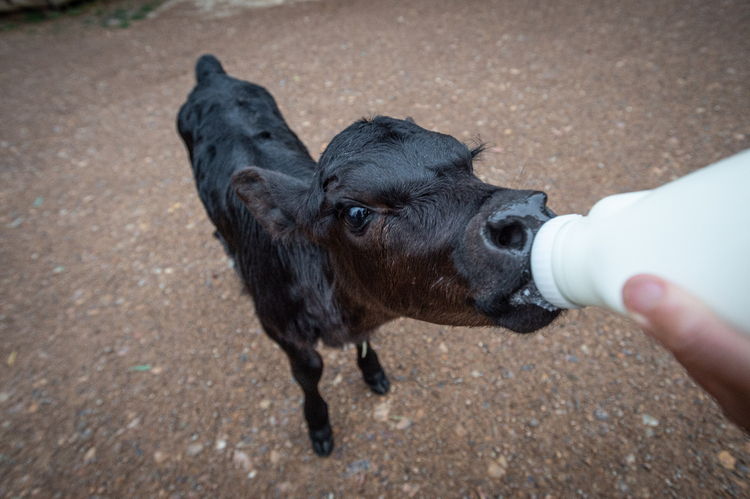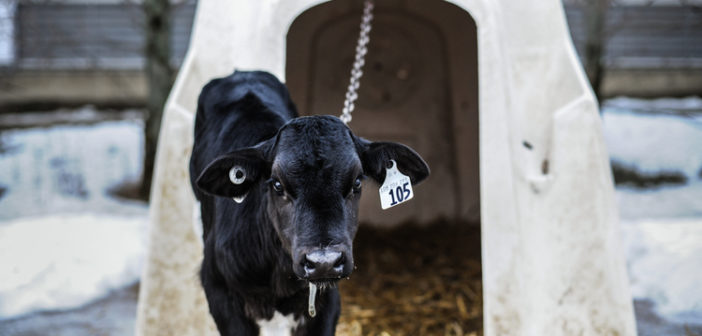What kind of a man writes an article describing the abuse of animals in the pig confinement facilities in Iowa and then reads the draft of the article to his 12-year old daughter? Jack Garcia. Actually, his daughter, Rachel, was the kind of daughter who shared with her parents an interest in animal rights and environmental issues. She was most sensitive to the plight of the “little veal calves,” as she called them. Rachel knew that these calves were kept in cramped conditions to produce “tender veal.” She made an unusual request on the occasion of her Bat Mitzvah (coming of age celebration for a Jewish girl): she asked her father to rescue the little veal calves. This would mean a “calfnapping” and transport to an animal sanctuary.
Jack accepted the challenge, but it would take some crafty deception and what he calls “compassionate mendacity.” Since he was an activist and published critic of meat producers, he might be a suspect when the police investigate the crime. He would need an alibi: people who would swear he was not in the area when the crime took place. To secure this link in the plan, Jack called Mrs. Schwarz of Mrs. Schwarz’s Boarding House in Queens, New York. Mrs. Schwarz was a dear friend of Jack’s wife and a secret supporter of Jack’s projects. Mrs. Schwarz agreed to fix the books to show that Jack and his family were recorded as staying with her at the boarding house at the time of the incident — hundreds of miles away from the scene of the crime.
To avoid violence and other problems, the calfnapping would have to be an inside job. Using his acting background, Jack would have to disguise himself and get hired at a facility where veal calves are raised. He had in mind an alter-ego; he would assume the identity of a retired ranch hand he had found out about through a friend who owned a cabin at Big Bear Lake in Southern California.
Pete Sanford, Jack’s friend, had confided in Jack, telling him the curious story of a tenant of his on the lake. A year ago, Harold Jones rented Pete’s cabin at the lake. Harold had retired after working at ranches that raised veal calves in Shasta County, California.
Pete said, “Harold told me he became disillusioned with the whole veal production process. He was a slim, good looking guy. Actually, he kinda looked like you, Jack. He was a loner, like a hermit. Harold would use the old, leaky dinghy that belonged to the cabin and spend hours rowing on the lake. But the last time I saw him I asked him about the dinghy and he said, ‘She’s taking on water and I don’t know if I can bail her out anymore.’ I didn’t hear from Harold after that, so I went out to the cabin. Everything was in place, like Harold had just gone out for a walk. But there was no sign of Harold and no sign of the dinghy anywhere on the lake. It’s been two weeks now, and I don’t know what to do. My guess is that Harold and the dinghy are at the bottom of the lake. No one knows anything about Harold– just me, and now you. I don’t want any investigations or complicated legal problems about this.”
Jack offered a solution. He would assume Harold’s identity, move to Ohio, and apply for a job. Pete could simply say that Harold had moved away. Jack could use some of Harold’s personal items and vital documents so as to present himself as a believable Harold Jones.

What kind of a man would disguise himself and risk incarceration for stealing twenty bovine calves, not for financial gain, but to relieve their suffering and to fulfill his daughter’s Bat Mitzvah wish? Jack Garcia’s concept for the heist was meticulously planned and smoothly executed. Meticulousness called for Jack to become Harold Jones and travel to Columbus, Ohio to meet with Tim Watson, head of the animal rights group called ADG (Animal Defense Group). Jack wanted Tim’s participation because of his background as a veterinarian and a seasoned activist.
Tim was surprised to meet a California ranch hand with a detailed plan to rescue veal calves. Tim agreed to use his medical skills and supply two livestock trucks. Five ADG members would help load the animals and make sure the country road route was “Smokey-free.” Tim contracted with a rancher whose buildings would be the sanctuary for the 20 rescued calves. The ranch is not an officially designated animal sanctuary and this is intentional. The owner helps ADG by being an “unknown” hideaway for lost or stolen animal souls.
Harold and Tim decided Harold should try for a job at Tennyson Veal Ranch, because Tim had seen how cruel Tennyson was and because its location would be ideal for the proposed heist. Finally, Tim preferred Tennyson because he knew the owner was, as he says, “not too swift.”
With acting skills and Tim’s coaching, Harold secured employment with Tennyson. Because of his experience tending veal calves, Harold became the lead attendant in the veal barn. After two weeks of “Mr. Reliable” performance, Harold could now update Tim, confirm all the details and finalize the date and time. Two days before the calfnapping, Harold wiped down the entire veal barn and began wearing gloves. The real Harold’s baseball cap, work gloves, and drinking cup were placed in the barn. In case overzealous police went looking for DNA, they would be looking at residue from the missing California ranch hand.
The two livestock trucks arrived at the Tennyson veal barn at 2:00 a.m. on Saturday night. Harold had arrived before them, disarmed the alarms, and detached the crates the calves lived in. Harold left this note for his supervisor and the owner:
Bosses:
I’m sorry. I could not bear to watch the calves suffer every day. I have to let them go. I have read on the Internet that some veal producers are “humane” and not cruel. But you and I know that many veal producers are cruel. I guess you will say it is a crime what I do. But I feel it is a far greater crime to keep the little calves here in these conditions. They cannot move and they are sick.
Harold
With the calves in the trucks and Tim Watson and Harold in the first truck, the gang slowly began the 20 mile transport to the sanctuary. A fleet of ADG cars accompanied the trucks, with three cars in front of the trucks and three behind. The cars were separated by a quarter mile and connected by cell phones. ADG’s Charlie Train was the tail of the cars in the rear, keeping an eye on his rearview mirror. He knew that the Ohio Highway Police occasionally patrol this road.
In the 16th mile, as Charlie remembers it, a Smokey appeared in his mirror, reflected in the occasional roadside lights. Charlie commenced his distraction plan, first with some random jerks, followed by wildly erratic driving. Then he suddenly pulled over onto the shoulder and jumped out of his car, clutching his chest and waving at the police. As Charlie had hoped, the police cruiser pulled over behind Charlie’s car, bull horn blaring.
“What seems to be the problem?”
Charlie bleated out: “I can’t drive! Chest pains! Take me in your car to the hospital,” pointing back, away from the livestock trucks.
After a few tense minutes the police officer decided to call for an ambulance. By this time, Charlie had saved the day. The trucks had just then turned into the sanctuary road and disappeared into the grove hiding the buildings.
To Charlie’s chagrin, the ambulance arrived with sirens and flashing lights filling the night sky. In emergency mode, the ambulance whisked him back toward the hospital, the EMTs applying oxygen and nitro capsules to the dying patient. At the hospital, Charlie was able to convince the doctors that he had eaten too many chili peppers for dinner. His heart attack turned out to be heartburn.
Charlie Train was kept in recovery for monitoring, giving him a chance to call Harold and ask about the living cargo. The one-year-old calves had arrived safely. The sanctuary rancher posted a YouTube video of the rescued calves, which showed no indicators of the location, thus protecting the “hidden” status of the sanctuary. Rachel Garcia was delighted to see that the little veal calves were liberated.

Veterinarian Tim Watson and the sanctuary farmer could now begin the rehabilitation program. It takes several months to restore the health of veal calves. Veal is supposed to be “creamy white and tender,” the result of dietary and movement deprivation.
Assured of the rehabilitation program, the ADG fleet could return home. The star fleetman, Charlie, was finally released and taken back to his car to drive home as the sun lit up the outskirts of Columbus, Ohio. Harold could now morph back into Jack and join his wife and daughter, who were visiting friends and family in Queens.
Along with the rescue, an integral part of Jack’s plan was “a blanket of information.” Just before the heist, Harold, wearing surgical gloves, used the Tennyson computer to post videos of the calves and publish his note to the bosses. Using Harold’s name, Jack wrote seven different articles explaining various aspects of veal production. These were sent by US mail to arrive at the offices of magazines and newspapers the day after the calfnapping. The manuscript folders bore postmarks from random locations across the country.
Anxious to vent his rage, the Tennyson CEO, Max Blonston, was able to get an interview with CNN, to be aired three days after the heist. Max called Harold a self-righteous, arrogant bastard who claimed to own the correct definition of the word “crime.” Blonston argued that stealing was worse than anything Tennyson had done in 30 years of producing veal.
The CNN reporter confronted Blonston: “Clearly Harold’s letter was referring to suffering — saying Tennyson caused the animals to suffer.”
Blonston offered this response: “Animals are on a low level. They don’t really suffer.”
Aiming for a wrap, the reporter said, “There you have it! Tennyson says animals don’t experience suffering! Tell that to my dog. He would not believe you!”
Blonston insisted on making one final point: “Tennyson will pay $100,000 to anyone who offers information that helps us find the criminal Harold Jones.”
Six months later, the Tennyson CEO discovered that One Earth Publishing (OEP) had published a book titled Little Veal Calves by Harold Jones. OEP is a small, tight-knit publishing company devoted to environmental and animal rights issues. Blonston sent two pretty girls to OEP to find out Jones’ address. They got as far as the Senior Editor, claiming they belonged to the “Lesser Crimes Group,” all strong supporters of Harold and his mission to free abused animals. Harold had forewarned OEP about apparent admirers trying to find him.
The editor sent the girls away with this: “I’m sorry. The only response we are authorized to give to inquirers is this: ‘No contacts. Whereabouts unknown.’”
Featured image: a veal calf chained to a crate. Image credit Jo-Anne McArthur / We Animals.





